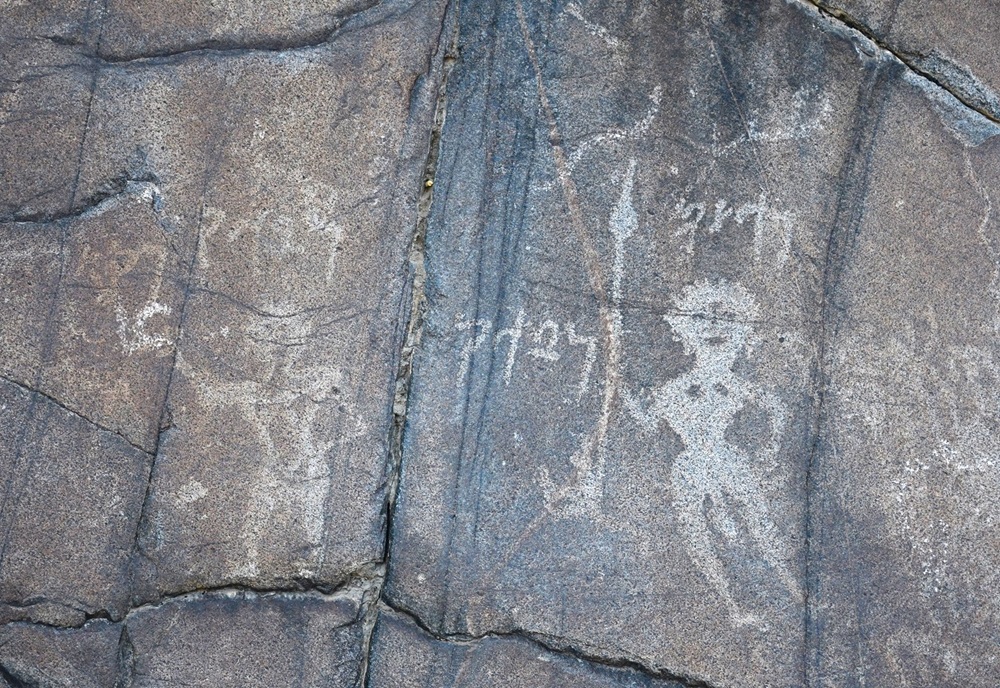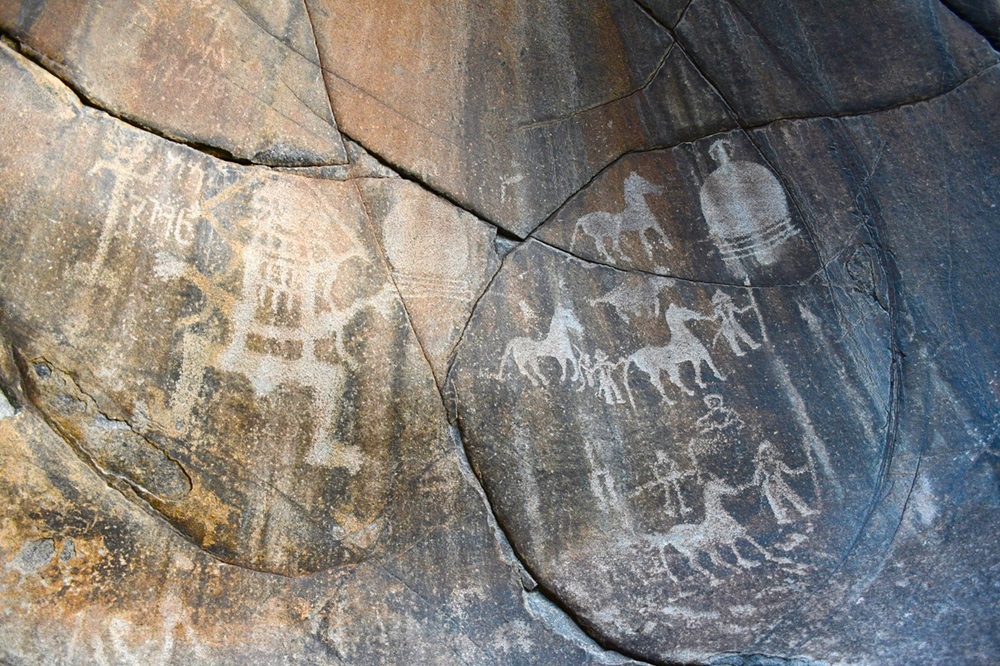Written by: Zulfiqar Ali Kalhoro
Posted on: July 03, 2024 |  | 中文
| 中文
A closer view of an engraved boulder at Chilas II (Picture credits to Zulfiqar Ali Kalhoro)
Chilas in Gilgit-Baltistan's Diamer district is known for its prehistoric and historic petroglyphs. There are six rock art sites, each containing excellent engravings that reflect the rich cultural heritage of Gilgit-Baltistan. This article will focus solely on the rock carvings of Chilas II. The site is located about 2 km from Chilas Gate on the Karakoram Highway, overlooking the left bank of the Indus River. What makes this site unique is the magnificent engravings of Kharoshthi, Brahmi, and the late Brahmi inscriptions. These rock carvings are found on rock walls and boulders. The rock walls and boulders lie close to the river Indus. On the way to the main rock art site, one spots a large boulder which is fully covered with petroglyphs. There are several depictions of stupas on this boulder. The main form of the stupa is a tower-like stupa. It is also likely that these are representations of temples rather than stupas. A few sun discs are also found on the surface of the boulder. Apart from stupas, sun discs, and other geometric designs, one also notices ritual scenes and human and animal figures. A few human figures are shown carrying a rafter or some other object. There is also very engaging engraving on this boulder. These carvings were made in different periods, each reflecting a unique aspect of the region's cultural heritage.
Professor Dr. Ahmad Hasan Dani, the first Pakistani scholar to systematically study these rock carvings, played a pivotal role in understanding the history of the Chilas II rock art site. His meticulous readings of the inscriptions, revealed in his book, Chilas: The City of Nanga Parvat (1983), allowed him to date the carvings and identify figures and names mentioned in the Kharoshthi, Brahmi and late Brahmi inscriptions. His contributions to the study of the Chilas II rock art site also discussed in his book “Human Records on Karakorum Highway (1995)”, are a testament to the site's historical significance.
According to Professor Dr. Ahmad Hassan Dani, an interesting scene engraved on the southern face of the rock represents Maues, his soldiers, and the captured ruler. German scholars Professor Dr. Karl Jettmar and Dr. Volker Thewalt (1987), the authors of Between Gandhara and the Silk Roads: Rock Carvings along the Karakorum Highway, believe that it is a submission scene depicting a deity who is being offered a bowl. According to them, this shows gift bearer and dancers. Ancient inscriptions accompany this scene. In the Kharoshthi inscription, the name Moga rajasa (of King Moga), which Ahmad Hasan Dani identified with Scythian King Maues. Looking at the rock face, one notices three rows of carvings. In the upper is shown horses, and in the middle is seated Maues with standing soldiers holding spears in their hands. On the right of the same row, one can see a fat man tied to a soldier's leg, which Professor Dr. Ahmad Hasan Dani believes is a carving of a defeated ruler being presented to King Maues. In the lower row, one notices a stupa image on the left surrounded by horsemen and a few standing figures, probably representing some noblemen welcomed by soldiers or aristocrats. This is one of the most magnificent scenes represented at Chilas II. One does not find such a scene representing Maues in any other rock art site in Gilgit-Baltistan. Professor Dr. Ahmad Hasan Dani also identified the names of the governors of Maues in the inscriptions found on another rock wall. To the left of King Maues, soldiers and a defeated ruler panel, there is another panel on the other rock that shows a seated Buddha with a pilgrim holding a water pot in his hand. It is accompanied by the Kharoshthi inscriptions.
To the left of this engraved rock wall, there is another rock wall that is fully covered with petroglyphs from different periods. This rock wall has engraved hunting and fighting scenes, human figures, animals, equestrians, stupas, tridents, deities, and geometric designs. Interestingly, depictions of three elephants are also found on the recessed rock wall. Such refined carvings of elephants are not seen elsewhere in Chilas. Two of the representations of elephants are engraved on the right of the ‘stupa with pillars’. The stupa with pillars is one of the most magnificent carvings at Chilas II. One learns from Between Gandhara and the Silk Roads: Rock Cravings Along the Karakorum Highway by Professor Dr. Karl Jettmar and Dr. Volker Thewalt (1987) that this form of the stupa is dated to the first century A.D. I have seen several such stupas with pillars at Thalpan and Shing Nala in the Diamer district. A few are also accompanied by inscriptions, thus making it much easier to know the dates of the carvings.
Below the carving of a stupa with pillars at the Chilas II rock art site, one can also see images of a lion and a bull. Bull images are rare in the upper Indus valley, but they are a recurrent theme in the rock art of Sindh. Some bull petroglyphs can also be seen in the Middle Indus, especially at Bagh Neelab in Attock district.
The third elephant carving is found adjacent to another stupa with steps. This stupa has been vandalised, as someone has written his name over it. When I first visited this site in 2000, there was no vandalism. Now, visitors have written their names over ancient engravings. There are a few remarkable engravings near the images of the stupa and elephant. One can see a warrior standing on horseback with extended arms wielding a large battle axe. One can also notice an engraving of another large axe on the same rock wall. It is literally impossible to discuss every carving found on this rock wall in this article. However, I want to discuss the carvings of Vasudeva and Baladeva, which are engraved on the extreme right of the image of a stupa with a pillar. Both figures are accompanied by the inscriptions. On the top of the figure of Baladeva is an engraving of a simple stupa. The image of a seated Buddha is found to the left of this simpler stupa. The entire surface of the rock wall is covered with numerous carvings and inscriptions. The carvings of Krishna and Balarama are also found at the Chilas II rock art site.

Figures of Vasudeva and Baladeva at Chilas II rock art site (Picture credits to Zulfiqar Ali Kalhoro)
As one descends to the river Indus, one sees several boulders covered with petroglyphs. However, a few panels at Chilas II depict Scythian soldiers. One of such panels, facing the riverside in an alcove, depicts soldiers with horses holding spears and moving to the domed stupa. There are two stupa images on this panel. Between both stupas, Scythian soldiers with horses are represented. On the left is another stupa. Close to this stupa is an image of Hariti, a Buddhist deity that looks dim now. Weathering effects are visible in Hariti's figure, and Indus water left the sludge in the figure, making it appear faded. To the left of the Hariti’s figure is a symbol of a column and a Kharoshthi inscription. Professor Dr.Ahmad Hasan Dani read the inscription, and based on the Kharoshthi inscription, he identified it as a craving of Hariti. On the fringe of the same rock are two stupa representations with inscriptions. Before one of the stupas is a standing figure.

Hariti on the left and Scythian soldiers before stupa on the right (Picture credits to Zulfiqar Ali Kalhoro)
To the right of the Hariti and Scythian soldiers panel, there is another alcove depicting two panels. The first panel shows Scythian soldiers before the stupa. Another stupa on the right of the first and on the fringe of the alcove shows the donor's name in Kharoshthi as Rahulasa (of Rahula). Khorashthi and Brahmi inscriptions surround the stupa and column.
The depictions of stupa adoration, each with unique features, are found at Chilas II. A few are engraved along with monks, adding a spiritual dimension to the site. One of the best specimens is located very close to the river Indus. On the southern face of the rock is depicted a Buddhist monk before a stupa. The stupa is built over a double square base. On the left of the steps is found the Kharoshthi inscription. On the top is a figure of another monk who is depicted holding a water pot and probably carrying a flag. Another depiction of stupa adoration is found in Chilas II. On one of the panels, a Buddhist monk venerates a stupa with a Kharoshthi inscription. Two votive stupas are also represented in this panel. The figure of the second monk is shown behind the first monk, who is holding an incense burner. Below this panel is the figure of Sakyamuni (Buddha), as believed by Professor Dr. Ahmad Hasan Dani
A bit further south of these engraved rock walls and alcove are about seven panels on a cliff. A few of the panels represent prehistoric hunting scenes.
The writer is an anthropologist. He has authored 15 books on Pakistan's cultural heritage and anthropology. He tweets @kalhorozulfiqar
You may also like: